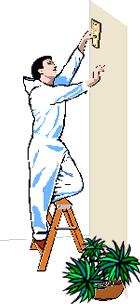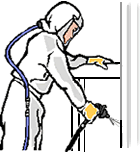Ask
us about our portable
air scrubber* rental service!
1
(877) 881-6653
{1
(877) 881-MOLD}
|
| |
|
|
| |
*An "air
scrubber" is a commercial version of a HEPA-filter-equipped
air filtration device for capturing mold spores
from the indoor air. It can also be used as a
"negative air machine" --please see Remediation
FAQs.
|
|
Also
available--
~
Asbestos
Testing
~
Concrete
Testing
· moisture
· calcium chloride
· alkalinity
~
Formaldehyde
Testing
~
Lead
Testing
~
1
(877) 881-6653
{1
(877) 881-MOLD}
|
|
|
|
1
(877) 881-6653
{1
(877) 881-MOLD}
AAA Mold
Inspection Services (Asbestos Testing and Lead Testing
Also Available)
provides
you with professional assistance--certified mold inspectors--to
find mold that could be hidden inside your walls, ceilings,
floors,
basement,
crawl
space, attic, as well as HVAC equipment and ducts. All technicians
are certified and experienced in mold inspection (mold assessment)
and mold testing; training
includes
sampling protocols and use of state-of-the-art
equipment.
Our mold
inspection features
· Certified,
experienced, and professional technician.
· Complete examination of structure's interior, including moisture-meter-testing
of possible water intrusion points.
· Air, swab, fragment,
or ATP* (*see next bullet) sampling available with the number
of samples controlled by you, the customer.
· ATP Sampling: bio-contamination
testing on surfaces or in liquids (including gray water, black
water, and sewage) with instant
and accurate results [this
is an ATP molecules quantity test (quantification of intercellular
microbial ATP)--click
here for additional information].
· Selected samples requiring
laboratory scrutiny are attached to a “Chain of Custody” document,
meeting legal standards for evidence, and sent to certified
laboratory.
· A written report
of inspection discoveries, laboratory findings of identified
mold genera (if applicable), and remediation
recommendations, if needed.
Our
mold inspection service areas
include
the following cities in central California, U.S.: |
| |
· AMADOR
· ANTIOCH
· AUBURN
· BERKELEY
· DALY CITY
· DIXON
· DUBLIN
· EL DORADO HILLS
· ELK GROVE
· FAIR OAKS
· FAIRFIELD |
|
· FOLSOM
· FRESNO
· GALT
· GRANITE BAY
· GRASS VALLEY
· HAYWARD
· LAKE TAHOE
· LINCOLN
· LIVERMORE
· LODI
· MARYSVILLE |
|
· MODESTO
· MONTEREY
· NAPA
· OAKLAND
· PITTSBURG
· PLEASANTON
· RANCHO CORDOVA
· RICHMOND
· ROCKLIN
· ROSEVILLE
· SACRAMENTO |
|
· SAN
FRANCISCO
· SAN JOSE
· SAN RAFAEL
· SAN RAMON
· SANTA CRUZ
· SONOMA
· STOCKTON
· TRACY
· TRUCKEE
· VACAVILLE
· WALNUT CREEK |
|
Our
mold inspection certifications:
Certified IAQ/Mold Inspector [CMI] certification is
issued by the National Organization of Remediators
and Mold Inspectors [http://www.normi.org/]
to Curtis Roberts, with membership verified at the following
page--
http://www.normipro.com/cgi-bin/prosearch/prozip.cgi?Status=Active&x=15&y=93
We
are committed to treating our customers with
honesty, kindness, respect, and professionalism.
|
|
|


Mold & Your
Health

|
|
It is a fact that molds produce allergens and irritants
that can cause exposed individuals to experience symptoms
of
hay fever, i.e., sneezing, runny nose, skin rashes, irritated
eyes, as well as nose, throat, and lung ailments.
Many toxic molds produce poisonous substances called mycotoxins.
These toxins interfere with cell structures and processes,
and have the potential to cause serious health issues. Their
effects to the human body have been documented using controlled
conditions in a laboratory. Mycotoxins have been proven to
be present indoors with victims suffering from:
- pulmonary hemorrhage or pulmonary hemosiderosis (primarily
in infants),
- headaches and other flu-like symptoms,
- nosebleeds,
- immune system suppression (resulting in increased
numbers of infections),
- hair loss,
- chronic fatigue,
- psychological depression,
- diarrhea,
- sore throats,
- dermatitis.
Other symptoms that have been associated with
mold:
- "burning" eyes,
- blurred vision,
- respiratory illness,
- chest pains,
- chest tightness,
- shortness of breath,
- wheezing,
- dry cough,
- nasal congestion,
- aggravated asthma,
- cognitive disorder.
|
|

Inspection FAQs

|
|
Can I have a mold problem if my house is only two years old?
Actually, given the proper conditions, mold colonies can
appear within twenty-four to forty-eight hours. There
have also been incidents where wood building products
were contaminated with mold prior to being fastened in place
at the home construction site.
Why can't I proceed directly to
the remediation of the mold?
You can, but we recommend a mold inspection that includes
moisture measurements of floors, walls, and ceilings. Any
materials
with a high
moisture content can indicate hidden mold growth.
Comparison of air and mold samples can also indicate hidden
mold, as
well as reveal what kind of mold you are dealing with.
We will be happy to discuss different mold inspection options
that best fit your needs and budget.
Should
a mold inspection be included in the list of pre-purchase
property inspections?
A mold
inspection can provide invaluable information about
any structural investment you are considering purchasing. Home inspectors
sometimes report mold when it is visible, but they typically
do not have the aid of specialized equipment that reveals hidden
problems (please see the following answer). And, through air
sampling, the Certified Mold Inspector can alert you if
there is a mold-related indoor air quality problem.
What
are some of the features of the mold inspection?
A Certified Mold Inspector will conduct an indoor
environmental visual examination (survey) that
is enhanced by state-of-the-art devices.
Some of these devices measure structural moisture (moist
conditions encourage mold growth), air particulates (high
particulate counts can be identified with an air
sampling device), and thermal variations (cool
areas may have a high moisture content). The
enhanced examination thus helps
pinpoint otherwise invisible moisture intrusion
areas
where hidden mold may exist (example:
inside
walls). Mold testing is also offered by the Certified
Mold Inspector and samples are collected by following
scientific protocols (there is more on mold testing in
the following answers). You
also receive a written
report
with recommendations
for your specific situation.
How can I benefit from mold testing?
Mold sampling (and testing)
will supply answers to questions like: Are mold spore counts
higher in my indoor air than naturally occurring mold spore
counts outside? What kind of mold (genus) is growing in my
home? Is the discoloration, found on the
floor (or attic) joists, mold? Sample analyses can
also assist your healthcare professional in identifying medical
problems
that
could be
related to mold.
And, should legal action become necessary, "chain of custody"
protected samples would be essential for providing evidence
of mold
contamination.
What standards exist for evaluating
indoor airborne mold quantities?
—Indoor mold spore counts should be similar
to those of the outdoor air in your immediate vicinity.— This
axiom
is supported by scientific principles and approved by recognized
authorities of air quality. These authorities
include, but are not limited to, the American Conference
of Governmental Industrial Hygienists;
the New York City Department of Health & Mental Hygiene,
Environmental & Occupational Disease Epidemiology. How do I know if the mold in my
house is toxic to my family and my pets?
It is difficult to be absolutely certain. Most mold sampling analysis does not
identify mycotoxins, but it does reveal the mold genus. Genus results
are compared to the list of molds that have the potential to produce
mycotoxins (a few are listed in the following answer).
What species of toxic molds are
commonly found in buildings?
Cladosporium, Aspergillus, Penicillium,
and Alternaria--all considered toxic.
Stachybotrys, Fusarium, and Trichoderma (also
considered toxic), produce mycotoxins that are easily
absorbed into skin, intestinal lining, airways, and
lungs. Other toxic molds include Coccidioides, Blastomyces, Histoplasma,
and Memnoniella.
How long will it take to receive testing results?
Collected samples will be promptly sent to an accredited
microbiology laboratory for analysis. Normal turn around
time for lab
results is two to three days.
|
|

Remediation FAQs

|
|
Does
homeowner’s insurance
cover any of the costs?
Mold remediation is sometimes covered by insurance, or it may
be included under water damage repairs.
You
will
need
to contact your insurance agent for details.
What are some of the features of
mold remediation?
Our technicians are trained
in and conform to accepted containment, removal, and treatment
procedures, ensuring that contamination does not spread to other
areas
of your home. HEPA air filters and vacuums are utilized
extensively to reduce the likelihood of cross contamination.
Without
these stringent procedures, thousands of mold spores could
be released, allowing possible mold contamination in other
areas of the structure. Remediation services include:
* HEPA
air filtration,
* HEPA vacuuming,
* negative air containment procedures,
* demolition, removal and replacement of damaged materials,
* cleaning and disinfecting of remaining building materials,
* antimicrobial treatment,
* attic and crawlspace treatment.
When are antimicrobial treatments
necessary?
Antimicrobial treatments
are useful when dealing with building materials that are
not easily removed. Areas such as attic sheathing
or crawlspace subflooring are expensive to replace and typically
the mold growth is only superficial. Antimicrobial treatments
provide an economical yet effective solution for these difficult
areas. Additionally the area can be sealed with a stain blocking
primer after the mold growth has been eliminated.
Where can the antimicrobial treatments
be applied?
Any accessible bare wood within the home can receive
the antimicrobial treatment. This includes attic sheathing
and rafters, crawlspace materials and exposed framing.
Are the antimicrobial chemicals
toxic?
No, the chemicals we use are registered with the EPA
as non-toxic and are commonly used in both the hospital and
construction industries.
Will I have to vacate my home
during the mold cleanup?
Generally, mold remediation does not compel you to temporarily move out of
your home. This is because the work area is enclosed in plastic sheeting (forming
an air containment), and isolated from the remainder of the house. Exceptions
include the remediation of a critical room, such as the kitchen or the sole
bathroom of the dwelling. For example, if your house or apartment has only
one bathroom (and that room requires remediation) it may be necessary for you
to arrange for temporary quarters elsewhere. Individual room mold abatement
can typically take four to ten days to complete (your unique situation may
vary from this), and will not be accessible by you during that time. Other
work condition considerations are covered in the next question.
What conditions can I expect to
encounter during the mold removal?
While working in the containment, our certified technicians will wear Tyvek® suits
(made of white tear-resistant paper that provides a dry particulate barrier)
and air filtering respirators. Many of the moldy and water damaged materials
will need to be removed from the premises. All affected wood studs will be "scrubbed" (sanded)
to remove discoloration, vacuumed with a vacuum cleaner (HEPA filter equipped),
and then sprayed with a fungicide. Air-moving blowers called "negative
air machines" take in air from the containment and are exhausted to the
outside--to create a fresh air flow into the containment. These blowers
can also be used as air "scrubbers" to
filter out mold spores while recirculating air. Dehumidifiers may also be used
to
remove moisture from the structure. These machines make a loud noise, and some
must run constantly for the duration of the remediation and post-remediation
testing periods.
Why must I test for mold again
after the remediation?
It is very important to verify the effectiveness of the cleanup. Work can be
evaluated using what is called post-remediation sampling, or clearance sampling.
The clearance inspection and sampling are performed after the remediation is
complete, but before the rebuilding (restoration) of the affected area. When
the post-remediation sampling test results are satisfactory, the Post-Remediation
Sampling Report provides professional third party documentation that the mold
was effectively and completely removed.
|
|

|
|
AAA Mold Inspection Services--1
(877) 881-6653 {1
(877) 881-MOLD}
|
|
| |
|
|
| |
This
site is published by AAA Mold Inspection Services; all
rights are reserved.
|
|
 |